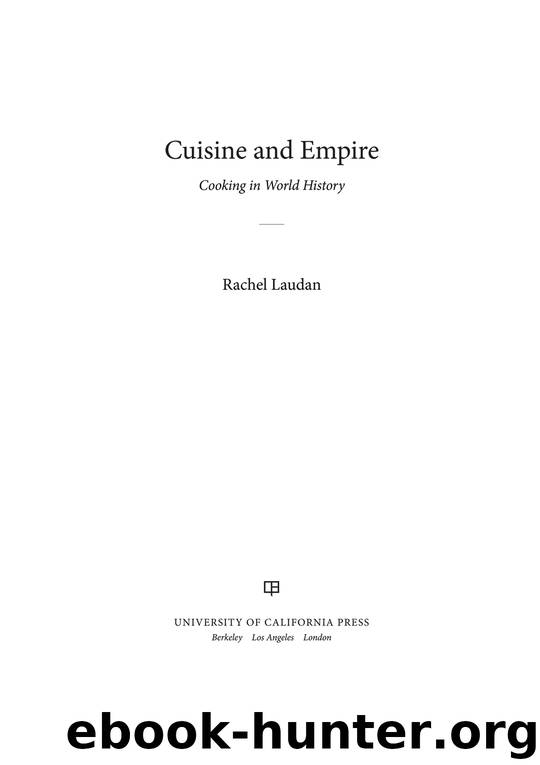Cuisine and Empire by Rachel Laudan

Author:Rachel Laudan
Language: eng
Format: epub
ISBN: 9780520266452
Publisher: University of California Press
FIGURE 6.8. This engraving shows food and drink being distributed to the populace in Strasbourg in October 1744 to celebrate Louis XV’s recovery from illness and entry into the city. What appears to be bread is being tossed from the balcony, people by the fountains are raising tankards, and on the right a butcher is about to slaughter an ox. Engraving by Jacques-Philippe Le Bas after a drawing by Johann Martin Weis. From Paul Lacroix (pseud. Paul-Louis Jacob), XVIIme siècle: Institutions, usages et costumes (Paris: Firmin-Didot, 1880).
Efforts were made to ensure the bread supply. Frederick the Great in Prussia, for example, stockpiled grain so that bread could still be made following poor harvests. The French government offered prizes for improvements in milling, hoping to increase the yield of quality flour from grain. Most radically, liberals such as Anne-Robert-Jacques Turgot and the Physiocrats in France and Adam Smith in England proposed that government controls on the wheat trade and wheat prices be replaced by free trade. When in the 1760s the French government acted on this, the poor felt their traditional security had been pulled from under them. The “moral economy,” as the historian E.P. Thompson called the belief in the right to food at a fair price, had been abrogated.98 Although the policy was reversed within a few years, the added insecurity was not.
For those who could not feed themselves, most European countries had “hospitals,” poor houses, or later workhouses, founded largely by the contributions of the urban middle class, which took the poor off the streets and put them to work, if they were fit enough, in return for giving them food and shelter. To combat hunger in Sweden, almanacs, sermons, and vernacular pamphlets recommended famine foods. Some, such as tulip bulbs cooked with butter and pepper; black currants mashed with sugar; asparagus; and cherry-tree resin, seem out of touch with what was likely to have been available. Others were more practical, time-honored fallbacks such as fir bark, nettles, burdock, acorns, Iceland moss, seaweed, bog myrtle, and thistles.99
The solution to the bread problem, the elite came to hope from the 1770s on, was the potato. It had been known in Europe since the late sixteenth century and grown in fields from the mid-eighteenth century, but it was still not a significant part of the diet. Accustomed as we are to potatoes, it is hard to realize that they were stranger to Europeans than taro and cassava are to modern Americans.100 As roots, potatoes seemed like turnips, which were thought of as winter cattle feed and thus for animals, not humans. They were often small and tasted bitter because breeding had not yet produced the varieties that we enjoy. Once harvested, they had to be kept cold or eaten quickly, or they went green and sprouted. When cooked they formed a bland, soft mass rather than aromatic, toothsome bread. The only place where potatoes were adopted with enthusiasm was in distant New Zealand. The Maoris, accustomed to the subtropical roots
Download
This site does not store any files on its server. We only index and link to content provided by other sites. Please contact the content providers to delete copyright contents if any and email us, we'll remove relevant links or contents immediately.
| Africa | Americas |
| Arctic & Antarctica | Asia |
| Australia & Oceania | Europe |
| Middle East | Russia |
| United States | World |
| Ancient Civilizations | Military |
| Historical Study & Educational Resources |
Cecilia; Or, Memoirs of an Heiress — Volume 1 by Fanny Burney(32495)
Cecilia; Or, Memoirs of an Heiress — Volume 2 by Fanny Burney(31909)
Cecilia; Or, Memoirs of an Heiress — Volume 3 by Fanny Burney(31892)
The Secret History by Donna Tartt(18945)
Sapiens: A Brief History of Humankind by Yuval Noah Harari(14319)
Leonardo da Vinci by Walter Isaacson(13235)
The Radium Girls by Kate Moore(11970)
Sapiens by Yuval Noah Harari(5322)
How Democracies Die by Steven Levitsky & Daniel Ziblatt(5170)
The Wind in My Hair by Masih Alinejad(5056)
Homo Deus: A Brief History of Tomorrow by Yuval Noah Harari(4871)
Endurance: Shackleton's Incredible Voyage by Alfred Lansing(4719)
Man's Search for Meaning by Viktor Frankl(4502)
The Silk Roads by Peter Frankopan(4488)
Millionaire: The Philanderer, Gambler, and Duelist Who Invented Modern Finance by Janet Gleeson(4420)
The Rape of Nanking by Iris Chang(4165)
Joan of Arc by Mary Gordon(4053)
The Motorcycle Diaries by Ernesto Che Guevara(4050)
Hitler in Los Angeles by Steven J. Ross(3923)
